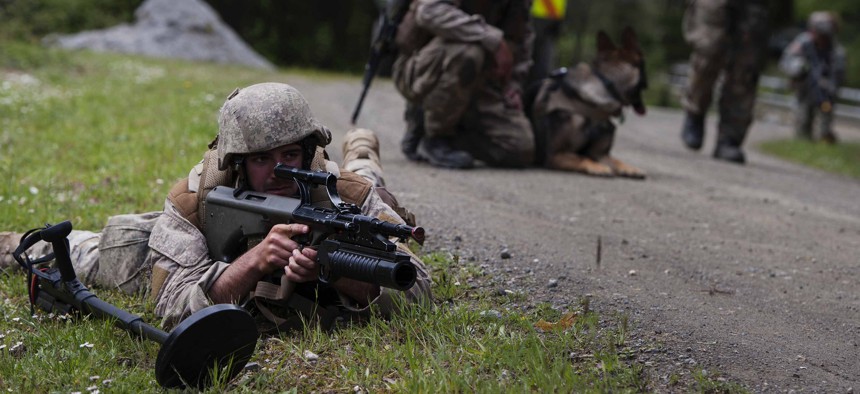
About 60 U.S. soldiers from the 25th Infantry Division at Schofield Barracks and 40 Marines from I Marine Expeditionary Force trained alongside about 600 New Zealand Defense Force soldiers during Exercise Kiwi Koru in 2014. U.S. Air Force / Staff Sgt. Christopher Hubenthal
The US Holds More Pacific Exercises Than You Probably Realize
The Army's Pacific Pathways program is even bringing some nations' military units to America for training.
The pivot to Asia is proceeding on track, at least by two measures, for the U.S. Army. The number of soldiers, Guardsmen, and civilians assigned to the Pacific has swelled to 106,000, up 17 percent since 2013, but more importantly, the number of exercises with partner nations has grown as well, Pacific Commander Gen. Robert Brown said at a roundtable Wednesday.
U.S. forces now participate in more than 100 joint and multinational exercises each year in the region, Brown said.
“You can see evidence of the rebalance,” he said. “That’s a good thing. It’s another change I’ve seen since coming back, over the last 10 years: a continued growth in multilateral exercises.”
Brown noted in particular the Pacific Pathways program, which allows U.S. Army units to spend several months in a series of exercises with Pacific partners’ militaries. The Army is “constantly looking at” growing Pathways and expanding to new locations, and for the first time is instituting a reverse-Pathways, in which allies’ troops train in the U.S., Brown said.
Under consideration? Sending a Pathways unit to Australia. Under way? A Japanese unit coming to Washington state for a reverse mission.
There are 36 countries in the Pacific region, all but nine of which have militaries. “I’ve met with around 21 nations … and every one of them—every one—has said, ‘Hey, we want a Pathways; we want more Pathways,’” Brown said. “And many are interested in the reverse-Pathways, again, coming back toward us.”
These partnerships are the Army’s contribution to the broader U.S. rebalancing in the Pacific -- a mission itself that aligns with the U.S.’s alliance commitments. The U.S. has seven collective-defense treaties, five of which are based primarily in the Pacific.
INSERT: Map of treaty alliances here (TK)
Instability and antidemocratic trends have not stopped the military-to-military relationships with Thailand and the Philippines, though they have complicated it. After the Thai military seized control of its government in 2014, the the U.S. suspended aid and scaled back the next year’s Cobra Gold, a long-running exercise between the two countries that now includes over 30 militaries.
“There was a look at what level of activities we should do, but Cobra Gold will happen,” Brown said.
More recently, the Philippine president Rodrigo Duterte has threatened to quit the U.N. and disparaged the U.S. for deaths of black men, after both condemned his policy of extrajudicial killing of drug suspects.
Brown said the Army works “very closely with, of course, the State Department and leadership on what’s the right thing to do,” but emphasized the humanitarian aid and disaster relief focus of many of the multilateral military exercises it conducts in the Pacific, including Cobra Gold.
“We’re looking to the Thais to get democratically elected government, but we continue to exercise in areas of mutual interest,” he said. “The more we do together, the less likely lives will be lost because we didn’t prepare, and that would be tragic.”
Of course, humanitarian assistance isn’t the only thing for which the Army readies itself. Being prepared to counter threats like North Korea, which just this week fired a submarine-launched ballistic missile that flew 310 miles toward Japan, is at the top of Brown’s mind as well.
“If you look at the current regime, that’ll make 31 launches in four years, and the former regime had like nine launches in 17 years,” he said. “Nowhere in the world, I believe is it more important to be ready to fight tonight than Korea.”
